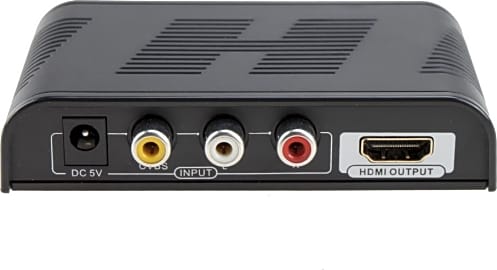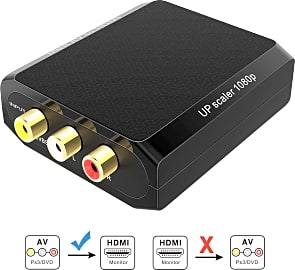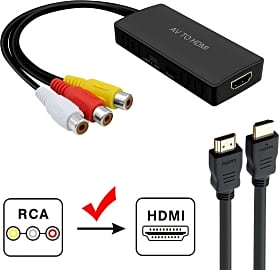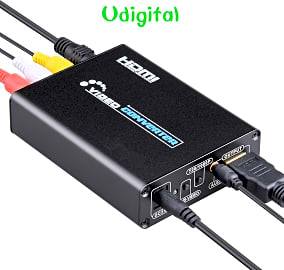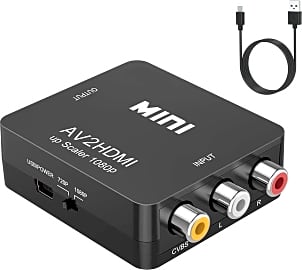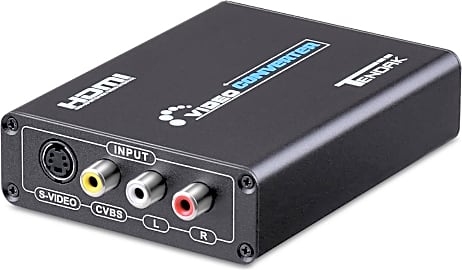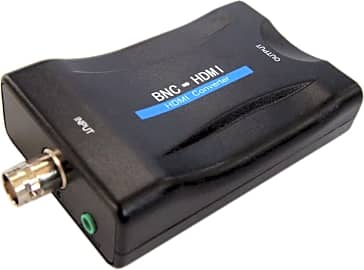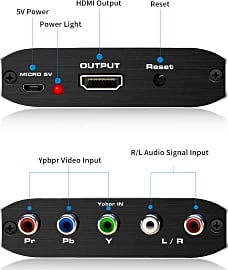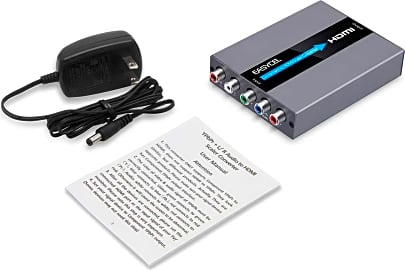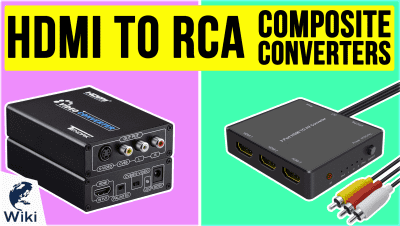The 10 Best AV To HDMI Converters

This wiki has been updated 35 times since it was first published in April of 2016. Like most of us, you probably still have some older equipment lying around along with your more modern audio-visual gear. But there's no need to throw it out just yet, as one of these AV to HDMI converters will allow you to view VHS tapes, DVD's or the feed from your analog security camera on your monitor or high-definition TV, or perhaps relive childhood memories on your old gaming system. When users buy our independently chosen editorial picks, we may earn commissions to help fund the Wiki.
Editor's Notes
November 03, 2020:
As I mentioned in my previous update of this list, analog video is old signal technology, so this market is fairly static, and there won’t be any revolutionary change or improvement in quality to the converters you find here today versus those you would have found a few years ago, though they may continue to shrink in size, as we’ve seen over the last few years – who knows. However, while they all have the same function, quality can obviously vary between converters, and even the manufacturing quality of a single model can change drastically between two time periods.
Updates to this list: Thus, it’s imperative to make updates as time goes on, and I’ve replaced older models and those that I felt were beginning to flag in quality. Though they do build most with of these with that same compact, square shape that you see on models like the Ablewe Mini, all models are all fairly similar in function and rendering quality, and so I wanted to introduce variety through form instead.
The RCA ports on the RuiPuo Composite, for instance, are detached from the body of the converter – which you won’t find on any of the other models – or, for those who want the ‘feel’ of something more substantial, a slightly bulkier model like the Udigital Converter or E-SDS High Definition may suffice. Another interesting variation that I’ve seen crop up on the market recently are models like the LVY RCA, which has two input channels, for those who may require running multiple devices.
Less Commonly Used AV inputs: While in the past, I’ve let the market determine the options in this list by virtue of which AV(Audio-Video) input type is most commonly sought by consumers – which has always been RCA – the truth is that there are many types AV inputs, and, though converters using these types of inputs are far less commonly sought, I thought I would round the list off by representing some of these options.
Firstly, while it’s quite hard to find an S-video-only-to-HDMI converter, you can often find S-video inputs right next to the RCA inputs on some models like Udigital Converter and Tendak CVBS.
Another common AV input is component video, also known as YPbPr, because of its connectors, which was developed after RCA in order to offer high-definition signal quality, so you’ll find YPbPr connectors on many DVD players and 7th-gen consoles like PS3 and Xbox 360, as well as plasma TV’s. I’ve just added two component converters to this list - Easycel Component, Koopman Adapter.
I’ve topped the list off with a high-quality BNC-to-HDMI converter, which deals with BNC inputs like DIN plugs – a far less commonly found AV input, though, many analog surveillance cameras and multiplexers use this.
Do note that none of these converters are reverse-compatible – that is, they can’t be used in the opposite direction, and convert a digital HDMI signal into an analog one – though, we do have separate lists for both HDMI-to-component converters, as well as HDMI-to-composite converters.
November 22, 2019:
While the best products in this converter category are relatively indistinguishable in terms of the results they provide as the whole market has pretty much reached a technological efficiency ceiling of virtually lossless transmission and it would be hard for models in the future to make any overall significant improvements to the market as a whole (the models from 2014 are as good as those released today), I still like to update old models with newer ones for the sake of renewal.
This is the case with the Enko Products (released in 2014), as well as those that are struggling with commonly-reported manufacturing-related quality issues like the Kawany Composite (perhaps as a result of the producer becoming sloppy/cutting back on costs) and I've replaced these old models with the RuiPuo Composite as well as the Wenter Scaler (both of which are newer, and have very clear, distortion-free transmission as well as zero audio-to-video lag).
The Kawany Composite was commonly reported to be struggling with lag, even though we may not be able to use the products for enough time to experience these issues ourselves. Since products are relatively similar here, I didn’t want to saturate this list for the sake of saturation and tried to avoid including products that were too similar, or I could have easily included more products. The Kawany Composite, for instance, was virtually a carbon-copy of the Gana Mini.
You will however find different issues related to different models and batch-testing products can very clearly highlight chronic issues (across devices of the same model) related to durability or performance. Amongst these different models, you may also observe qualitative differences with the naked eye, though we maintain that we only include products that have very good, sharp picture quality related to lossless transmission between AV and HDMI.
Who Needs An AV to HDMI Converter?
AV to HDMI converters allow those who are so inclined to play their old games on newer TVs.
AV to HDMI converters are popular with a lot of people, not simply technology buffs. To the outsider, this can be difficult to comprehend. But when the uses for these converters are explained, it is easy to see why they have become so popular.
To understand who benefits most from these converters, it is important to learn what they do. When most people speak of AV cables, they mean RCA cables. These are typically the cables with red, yellow, and white tips on them. These cables actually play a big role in the history of the television, as they provided a near-universal connection for audio and visual devices to be tethered to equipment. Until the recent invention of HDMI, RCA jacks were the standard. This means that there are still many products on the market that use AV cables and RCA jacks, and anyone who needs to use these with a new television may need a converter.
People with older camcorders will love the ease of a converter for displaying their memories on newer, high-definition televisions. Older video cameras used the familiar cables to connect to television RCA inputs. With a converter box, these same cameras can be attached to a high-definition TV via an HDMI port.
The 8-bit era may be long gone for many, but for some, 8-bit games provide a simple and nostalgic form of entertainment without breaking the bank on the newest systems. AV to HDMI converters allow those who are so inclined to play their old games on newer TVs.
Yet it is not just the 8-bit systems which use AV connections. Many other classic systems do as well, such as Super Nintendo and Sega Genesis. Nearly every gamer who plays older systems can benefit from an AV to HDMI converter. This is because even though some modern televisions still offer up AV connections, the image and audio quality may be greatly improved by converting to HDMI.
The same goes for playing classic movies from a VHS player. Instead of converting the entire collection to Blu-ray, there are still many who enjoy their VHS collection. For them, a converter is a much better investment than keeping an old television around, and it provides a higher-quality experience.
What Is The Difference Between AV and HDMI
AV is an abbreviation for audio/video. It has become a generic term used in home entertainment setups and products and is usually connected through some sort of RCA cable. The typical three-jack AV setup on most entertainment equipment includes a yellow sleeve for video, a red sleeve for the right audio channel, and a white sleeve for the left audio channel of stereo audio. These connect to the corresponding male jacks of the cable. RCA cables were created by the Radio Corporation of America in the 1940s, hence the name RCA.
This high definition is popularly used in home entertainment, where the highest quality experience is desired.
There are many types of AV cable, but most are either component AV cables or composite AV cables. The composite AV cable is the classic three-connection cable mentioned above. The component AV cable has three connectors for video and two for audio. This helps to produce a better picture. Composite AV inputs can be found on DVD players and VCRs, projectors, mixing boards, camcorders, and even CD players. Typically only newer HDTVs have component AV inputs.
Before these cables, quarter-inch phone connectors were the standard for much audio and visual equipment. While RCA cables were originally designed for home radios, they became the connection of choice until the HDMI cable came around.
HDMI stands for high definition multimedia interface. The importance of HDMI lies in the fact that it allows for uncompressed audio and video data to be transferred from an HDMI device to a display. This preserves the highest frame rate possible, and keeps audio from clipping or warping in the transfer from the playback device to the speaker. This high definition is popularly used in home entertainment, where the highest quality experience is desired. As technology becomes more immersive, the importance of high quality audio and video is undeniable to keep the illusion alive. In modern home entertainment, virtual reality, and even just for playing social media videos from a projector, HDMI is king.
HDMI also has educational uses as well, in medical labs and for experiments carried out within a video conference. The use of HDMI in these cases allows high definition streaming in real time, which can make every experiment a teaching opportunity.
What To Look For In An AV to HDMI Converter
When looking for an AV to HDMI converter, it is important to understand a few key things that make up a high-quality unit. Much of the concept behind these converters is to make old units viable again. In order to accomplish this, a unit must provide a clear channel for the signal to pass through. A converter will decode the AV signal to its original bits, and then re-route it to the HDMI port to be used. If done incorrectly, this can mean poor image quality.
A converter will decode the AV signal to its original bits, and then re-route it to the HDMI port to be used.
That is why one of the most important aspects of these devices is their build quality. It is often worth the extra cost to buy a high-end converter in order to ensure that the image is as clear as possible. It is important to note that the image will only be as good as the device capabilities. For instance, a 720p video recorder will not produce 1080p results on a newer TV by simply using a converter, but it will deliver the best quality possible.
Another thing to look for is whether the converter requires a power supply. Some units are passively powered, meaning they do not require an external electrical source to operate. Other converters will need their own power supply. If you only have limited space remaining on your power strip or would rather not clutter up your entertainment area with even more wires, look for units that can be powered by USB or battery.
One final thing to consider is lag time. Nearly all convertors will cause some amount of lag. It could be as little as a millisecond or as much as a full second. Picking an adapter made with high quality components will not only ensure a longer lifespan, but also reduce the possibility of experiencing any detectable lag between the input signal and the output signal.


